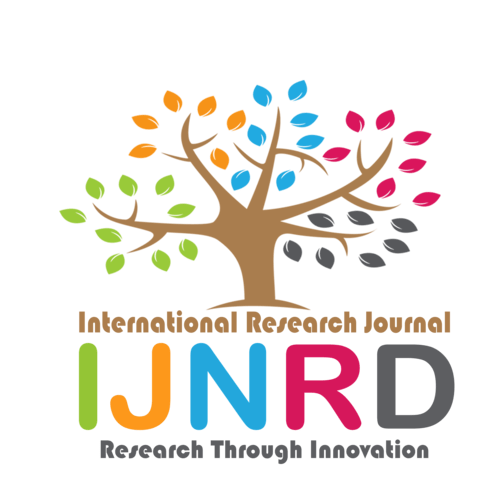|
|||||||||||||||

|
INTERNATIONAL JOURNAL OF NOVEL RESEARCH AND DEVELOPMENT International Peer Reviewed & Refereed Journals, Open Access Journal ISSN Approved Journal No: 2456-4184 | Impact factor: 8.76 | ESTD Year: 2016 Scholarly open access journals, Peer-reviewed, and Refereed Journals, Impact factor 8.76 (Calculate by google scholar and Semantic Scholar | AI-Powered Research Tool) , Multidisciplinary, Monthly, Indexing in all major database & Metadata, Citation Generator, Digital Object Identifier(DOI) |
||||||||||||||
Issue: April 2024
Volume 9 | Issue 4
Review Result and Publication of Paper within : 2-3 days
Click Here For more DetailsFor Authors
Forms / Download
Published Issue Details
Editorial Board
Other IMP Links
Facts & Figure
Impact Factor : 8.76
Issue per Year : 12
Volume Published : 9
Issue Published : 95
Article Submitted :
Article Published :
Total Authors :
Total Reviewer :
Total Countries :
Indexing Partner
Join RMS/Earn 300
Licence
This work is licensed under a Creative Commons Attribution-NonCommercial 4.0 International License







|
Published Paper Details
|
|
| Paper Title: | REMOVAL OF ACTIVE PHARMACEUTICAL INGREDIENTS FROM PHARMACEUTICAL WASTEWATER USING ORGANIC ACID MODIFIED PLANTAIN PEELS. |
| Authors Name: | Dr. Odenigbo Celestine , Ezeoyili Ogbonna Anthony |
| Download E-Certificate: | Download |
| Author Reg. ID: |
IJNRD_188218
|
| Published Paper Id: | IJNRD2303177 |
| Published In: | Volume 8 Issue 3, March-2023 |
| DOI: | |
| Abstract: | ABSTRACT: This review focused on the isotherm modeling of the removal of lead and metallic contaminants from pharmaceutical wastewater using activated oil palm empty fruit bunch. The heavy metals in pharmaceutical wastewater sample were revealed by the Atomic Absorption Spectrometry analysis, which proved that lead and cadmium metals are the most dangerous metals in the sample under analysis because they exceed the acceptable limitsgiven by World Health Organization. The nutritional value of the raw and activated oil palm bunch, revealed through proximate analysis, indicated an increase in adsorbent properties after chemical activation. The surface morphological analysis of the raw and activated samples revealed considerable increment in the number of the vacant pores for effective adsorption after acid treatment while the Fourier Transform Infrared Spectrometer analysis also indicated an increase in void spaces after activation due to the disappearance of certain functional groups. Kinetic, thermodynamic and isotherm modelling of lead and cadmium removal by adsorption were done using standard equations. Langmuir model closely followed by Temkin model were the most fitting models for the adsorption experiment. Pseudo-second order kinetic model is the most suitable kinetic model while the results from the thermodynamic analysis, such as change in enthalpy, change in entropy and standard Gibb’s free energy showed that the process is notspontaneous. The adsorption was carried out in batches to determine the effects of stirring time, temperature and dosage of the activated palm bunch on the removal of lead and cadmium ions.These process conditions were optimized with central composite design of response surface methodology with the aid of a design expert (version 13). The response was removal efficiency while the suggested model was quadratic. The predicted adsorbent removal efficiencies for lead and cadmium are 89.234% and 73.318% respectively at 69.150mins, 345.155°C and 0.266g adsorbent dosage. This was validated by carrying out the metal removal at the suggested conditions to obtain actual adsorbent removal efficiencies of87.82% and 72.51% for lead and cadmium respectively.Thus, activated oil palm bunch is economically viable and practically proven biomass waste for pharmaceutical wastewater treatment. |
| Keywords: | KEYWORDS: Residual gases, Pollution, Wastewater Treatment, Modelling, Enthalpy |
| Cite Article: | "REMOVAL OF ACTIVE PHARMACEUTICAL INGREDIENTS FROM PHARMACEUTICAL WASTEWATER USING ORGANIC ACID MODIFIED PLANTAIN PEELS.", International Journal of Novel Research and Development (www.ijnrd.org), ISSN:2456-4184, Vol.8, Issue 3, page no.b667-b699, March-2023, Available :http://www.ijnrd.org/papers/IJNRD2303177.pdf |
| Downloads: | 000118751 |
| ISSN: |
2456-4184 | IMPACT FACTOR: 8.76 Calculated By Google Scholar| ESTD YEAR: 2016 An International Scholarly Open Access Journal, Peer-Reviewed, Refereed Journal Impact Factor 8.76 Calculate by Google Scholar and Semantic Scholar | AI-Powered Research Tool, Multidisciplinary, Monthly, Multilanguage Journal Indexing in All Major Database & Metadata, Citation Generator |
| Publication Details: |
Published Paper ID:IJNRD2303177 Registration ID: 188218 Published In: Volume 8 Issue 3, March-2023 DOI (Digital Object Identifier): Page No: b667-b699 Country: Enugu, Enugu, Nigeria Research Area: Engineering Publisher : IJ Publication Published Paper URL : https://www.ijnrd.org/viewpaperforall?paper=IJNRD2303177 Published Paper PDF: https://www.ijnrd.org/papers/IJNRD2303177 |
| Share Article: | |
|
Click Here to Download This Article |
|
| Article Preview | |
|
|
|
Major Indexing from www.ijnrd.org
| Semantic Scholar | Microsaoft Academic | ORCID | Zenodo |
| Google Scholar | ResearcherID Thomson Reuters | Mendeley : reference manager | Academia.edu |
| arXiv.org : cornell university library | Research Gate | CiteSeerX | PUBLON |
| DRJI | SSRN | Scribd | DocStoc |
ISSN Details
 |
 |
ISSN: 2456-4184
Impact Factor: 8.76 and ISSN APPROVED
Journal Starting Year (ESTD) : 2016
DOI (A digital object identifier)
Conference
Open Access License Policy
Important Details
Social Media
| Copyright © 2024 - All Rights Reserved - IJNRD |












Facebook Twitter Instagram LinkedIn